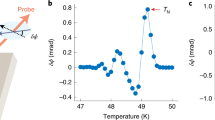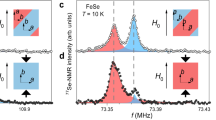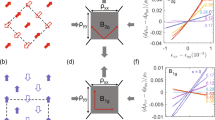Abstract
The origin of nematicity in FeSe remains a critical outstanding question towards understanding unconventional superconductivity in proximity to nematic order. To understand what drives the nematicity, it is essential to determine which electronic degree of freedom admits a spontaneous order parameter independent from the structural distortion. Here we use X-ray linear dichroism at the Fe K pre-edge to measure the anisotropy of the 3d orbital occupation as a function of in situ applied stress and temperature across the nematic transition. Along with using X-ray diffraction to precisely quantify the strain state, we reveal a lattice-independent, spontaneously ordered orbital polarization within the nematic phase, as well as an orbital polarizability that diverges as the transition is approached from above. These results provide strong evidence that spontaneous orbital polarization serves as the primary order parameter of the nematic phase.
This is a preview of subscription content, access via your institution
Access options
Access Nature and 54 other Nature Portfolio journals
Get Nature+, our best-value online-access subscription
$29.99 / 30 days
cancel any time
Subscribe to this journal
Receive 12 print issues and online access
$259.00 per year
only $21.58 per issue
Buy this article
- Purchase on Springer Link
- Instant access to full article PDF
Prices may be subject to local taxes which are calculated during checkout




Similar content being viewed by others
Data availability
Data associated with this paper are available on the Harvard Dataverse at https://doi.org/10.7910/DVN/SGZVX7.
References
Khomskii, D. I. Transition Metal Compounds (Cambridge Univ. Press, 2014).
Si, Q., Yu, R. & Abrahams, E. High-temperature superconductivity in iron pnictides and chalcogenides. Nat. Rev. Mater. 1, 16017 (2016).
Nandi, S. et al. Anomalous suppression of the orthorhombic lattice distortion in superconducting Ba(Fe1–xCox)2As2 single crystals. Phys. Rev. Lett. 104, 057006 (2010).
Pratt, D. K. et al. Coexistence of competing antiferromagnetic and superconducting phases in the underdoped Ba(Fe0.953Co0.047)2As2 compound using X-ray and neutron scattering techniques. Phys. Rev. Lett. 103, 087001 (2009).
Liu, D. et al. Orbital origin of extremely anisotropic superconducting gap in nematic phase of FeSe superconductor. Phys. Rev. X 8, 031033 (2018).
Chen, X., Maiti, S., Fernandes, R. M. & Hirschfeld, P. J. Nematicity and superconductivity: competition versus cooperation. Phys. Rev. B 102, 184512 (2020).
Wilkins, S. B. et al. Direct observation of orbital ordering in La0.5Sr1.5MnO4 using soft X-ray diffraction. Phys. Rev. Lett. 91, 167205 (2003).
Willers, T. et al. Correlation between ground state and orbital anisotropy in heavy fermion materials. Proc. Natl Acad. Sci. USA 112, 2384–2388 (2015).
Rosenberg, E. W., Chu, J. H., Ruff, J. P., Hristov, A. T. & Fisher, I. R. Divergence of the quadrupole-strain susceptibility of the electronic nematic system YbRu2Ge2. Proc. Natl Acad. Sci. USA 116, 7232–7237 (2019).
Li, J. et al. Spin-orbital-intertwined nematic state in FeSe. Phys. Rev. X 10, 011034 (2020).
Böhmer, A. E. et al. Lack of coupling between superconductivity and orthorhombic distortion in stoichiometric single-crystalline FeSe. Phys. Rev. B 87, 180505 (2013).
Baek, S. H. et al. Orbital-driven nematicity in FeSe. Nat. Mater. 14, 210–214 (2015).
Pfau, H. et al. Momentum dependence of the nematic order parameter in iron-based superconductors. Phys. Rev. Lett. 123, 066402 (2019).
Yi, M. et al. Nematic energy scale and the missing electron pocket in FeSe. Phys. Rev. X 9, 041049 (2019).
Shimojima, T. et al. Lifting of xz/yz orbital degeneracy at the structural transition in detwinned FeSe. Phys. Rev. B 90, 121111 (2014).
Watson, M. D. et al. Emergence of the nematic electronic state in FeSe. Phys. Rev. B Condens. Matter Mater. Phys. 91, 155106 (2015).
Wang, Q. et al. Strong interplay between stripe spin fluctuations, nematicity and superconductivity in FeSe. Nat. Mater. 15, 159–163 (2016).
Chen, T. et al. Anisotropic spin fluctuations in detwinned FeSe. Nat. Mater. 18, 709–716 (2019).
Massat, P. et al. Charge-induced nematicity in FeSe. Proc. Natl Acad. Sci. USA 113, 9177–9181 (2016).
Lu, X. et al. Spin-excitation anisotropy in the nematic state of detwinned FeSe. Nat. Phys. 18, 806–812 (2022).
Hosoi, S. et al. Nematic quantum critical point without magnetism in FeSe1–xSx superconductors. Proc. Natl Acad. Sci. USA 113, 8139–8143 (2016).
Tanatar, M. A. et al. Origin of the resistivity anisotropy in the nematic phase of FeSe. Phys. Rev. Lett. 117, 127001 (2016).
Bartlett, J. M. et al. Relationship between transport anisotropy and nematicity in FeSe. Phys. Rev. X 11, 021038 (2021).
Ghini, M. et al. Strain tuning of nematicity and superconductivity in single crystals of FeSe. Phys. Rev. B 103, 205139 (2021).
Chinotti, M., Pal, A., Degiorgi, L., Böhmer, A. E. & Canfield, P. C. Ingredients for the electronic nematic phase in FeSe revealed by its anisotropic optical response. Phys. Rev. B 98, 094506 (2018).
Schütt, M., Schmalian, J. & Fernandes, R. M. Origin of DC and AC conductivity anisotropy in iron-based superconductors: scattering rate versus spectral weight effects. Phys. Rev. B 94, 075111 (2016).
Baek, S. H. et al. Separate tuning of nematicity and spin fluctuations to unravel the origin of superconductivity in FeSe. npj Quantum Mater. 5, 8 (2020).
Huh, S. S. et al. Absence of Y-pocket in 1-Fe Brillouin zone and reversed orbital occupation imbalance in FeSe. Commun. Phys. 3, 52 (2020).
Cai, C. et al. Momentum-resolved measurement of electronic nematic susceptibility in the FeSe0.9S0.1 superconductor. Phys. Rev. B 101, 180501 (2020).
Fernandes, R. M., Böhmer, A. E., Meingast, C. & Schmalian, J. Scaling between magnetic and lattice fluctuations in iron pnictide superconductors. Phys. Rev. Lett. 111, 137001 (2013).
Park, J. et al. Rigid platform for applying large tunable strains to mechanically delicate samples. Rev. Sci. Instrum. 91, 083902 (2020).
Lebert, B. W., Balédent, V., Toulemonde, P., Ablett, J. M. & Rueff, J. P. Emergent high-spin state above 7 GPa in superconducting FeSe. Phys. Rev. B 97, 180503 (2018).
Joseph, B. et al. A study of the electronic structure of FeSe1–xTex chalcogenides by Fe and Se K-edge X-ray absorption near edge structure measurements. J. Phys. Condens. Matter 22, 485702 (2010).
Simonelli, L. et al. Electronic properties of FeSe1–xTex probed by X-ray emission and absorption spectroscopy. J. Phys. Condens. Matter 24, 415501 (2012).
De Groot, F., Vankó, G. & Glatzel, P. The 1s X-ray absorption pre-edge structures in transition metal oxides. J. Phys. Condens. Matter 21, 104207 (2009).
Modrow, H., Bucher, S., Rehr, J. J. & Ankudinov, A. L. Calculation and interpretation of K-shell X-ray absorption near-edge structure of transition metal oxides. Phys. Rev. B 67, 035123 (2003).
de Figueiredo, A. G. et al. Orbital localization and the role of the Fe and As 4p orbitals in BaFe2As2 probed by XANES. Phys. Rev. B 105, 045130 (2022).
Chen, J. M. et al. Electronic structure and characteristics of Fe 3d valence states of Fe1.01Se superconductors under pressure probed by X-ray absorption spectroscopy and resonant X-ray emission spectroscopy. J. Chem. Phys. 137, 244702 (2012).
Yamamoto, T. Assignment of pre-edge peaks in K-edge X-ray absorption spectra of 3d transition metal compounds: electric dipole or quadrupole? X-ray Spectrom. 37, 572–584 (2008).
Lee, C. C., Yin, W. G. & Ku, W. Ferro-orbital order and strong magnetic anisotropy in the parent compounds of iron-pnictide superconductors. Phys. Rev. Lett. 103, 267001 (2009).
Sanchez, J. J. et al. The transport–structural correspondence across the nematic phase transition probed by elasto X-ray diffraction. Nat. Mater. 20, 1519–1524 (2021).
Chen, C. C. et al. Orbital order and spontaneous orthorhombicity in iron pnictides. Phys. Rev. B 82, 100504 (2010).
Koch, R. J. et al. Room temperature local nematicity in FeSe superconductor. Phys. Rev. B 100, 020501 (2019).
Ishida, K. et al. Pure nematic quantum critical point accompanied by a superconducting dome. Proc. Natl Acad. Sci. USA 119, e2110501119 (2022).
Fanfarillo, L. et al. Orbital-dependent Fermi surface shrinking as a fingerprint of nematicity in FeSe. Phys. Rev. B 94, 155138 (2016).
Onari, S. & Kontani, H. In-plane anisotropy of transport coefficients in electronic nematic states: universal origin of nematicity in Fe-based superconductors. Phys. Rev. B 96, 094527 (2017).
Fernandes, R. M., Abrahams, E. & Schmalian, J. Anisotropic in-plane resistivity in the nematic phase of the iron pnictides. Phys. Rev. Lett. 107, 217002 (2011).
He, M. et al. Evidence for short-range magnetic order in the nematic phase of FeSe from anisotropic in-plane magnetostriction and susceptibility measurements. Phys. Rev. B 97, 104107 (2018).
Rhodes, L. C., Watson, M. D., Haghighirad, A. A., Evtushinsky, D. V. & Kim, T. K. Revealing the single electron pocket of FeSe in a single orthorhombic domain. Phys. Rev. B 101, 235128 (2020).
Udina, M., Grilli, M., Benfatto, L. & Chubukov, A. V. Raman response in the nematic phase of FeSe. Phys. Rev. Lett. 124, 197602 (2020).
Sun, J. P. et al. High-Tc superconductivity in FeSe at high pressure: dominant hole carriers and enhanced spin fluctuations. Phys. Rev. Lett. 118, 147004 (2017).
Wang, Q. et al. Magnetic ground state of FeSe. Nat. Commun. 7, 12182 (2016).
Sun, J. et al. Dome-shaped magnetic order competing with high-temperature superconductivity at high pressures in FeSe. Nat. Commun. 7, 12146 (2016).
Hanaguri, T. et al. Two distinct superconducting pairing states divided by the nematic end point in FeSe1–xSx. Sci. Adv. 4, eaar6419 (2018).
Acknowledgements
We thank R. Fernandes, M. Norman, J. Analytis, M. Le Tacon, J. Pelliciari, E. Ergeçen, Q. Jiang, P. Malinowski, M. Bachmann, M. Yi and H. Pfau for discussions. We thank L. G. Pimenta Martins and Y. Lee for assistance with preliminary X-ray experiments. Work at MIT (C.A.O., J.J.S., Q.S. and R.C.) is supported by the Department of Energy, Office of Science, Office of Basic Energy Sciences, under Award Number DE-SC0019126 (resonant X-ray spectroscopy and diffraction measurements, and sample growth), by the Air Force Office of Scientific Research Young Investigator Program under grant FA9550-19-1-0063 (strain set-up development and transport measurements), and by the National Science Foundation under grant no. 1751739 (optical dichroism). The work performed at the Advanced Photon Source was supported by the US Department of Energy, Office of Science, Office of Basic Energy Sciences under contract no. DE-AC02-06CH11357. Sample preparation was performed in part at HPCAT (Sector 16) at the Advanced Photon Source, Argonne National Laboratory. J.J.S. acknowledges the support of the National Science Foundation MPS-Ascend Postdoctoral Research Fellowship under award no. 2138167. Any opinions, findings and conclusions or recommendations expressed in this material are those of the author(s) and do not necessarily reflect the views of the National Science Foundation.
Author information
Authors and Affiliations
Contributions
C.A.O., J.J.S., G.F., Y.C., J.-W.K. and P.J.R. conceived the project and performed all X-ray measurements. Q.S. grew the samples. C.A.O. and J.J.S. prepared the samples for strain measurements, performed the optical birefringence measurements, analysed the data and wrote the manuscript. All authors contributed to the discussion of the results and commented on the manuscript. R.C. supervised the project.
Corresponding author
Ethics declarations
Competing interests
The authors declare no competing interests.
Peer review
Peer review information
Nature Materials thanks the anonymous reviewers for their contribution to the peer review of this work.
Additional information
Publisher’s note Springer Nature remains neutral with regard to jurisdictional claims in published maps and institutional affiliations.
Supplementary information
Supplementary Information
Supplementary Figs. 1–18, Discussion and refs. 1–16.
Rights and permissions
Springer Nature or its licensor (e.g. a society or other partner) holds exclusive rights to this article under a publishing agreement with the author(s) or other rightsholder(s); author self-archiving of the accepted manuscript version of this article is solely governed by the terms of such publishing agreement and applicable law.
About this article
Cite this article
Occhialini, C.A., Sanchez, J.J., Song, Q. et al. Spontaneous orbital polarization in the nematic phase of FeSe. Nat. Mater. 22, 985–991 (2023). https://doi.org/10.1038/s41563-023-01585-2
Received:
Accepted:
Published:
Issue Date:
DOI: https://doi.org/10.1038/s41563-023-01585-2



